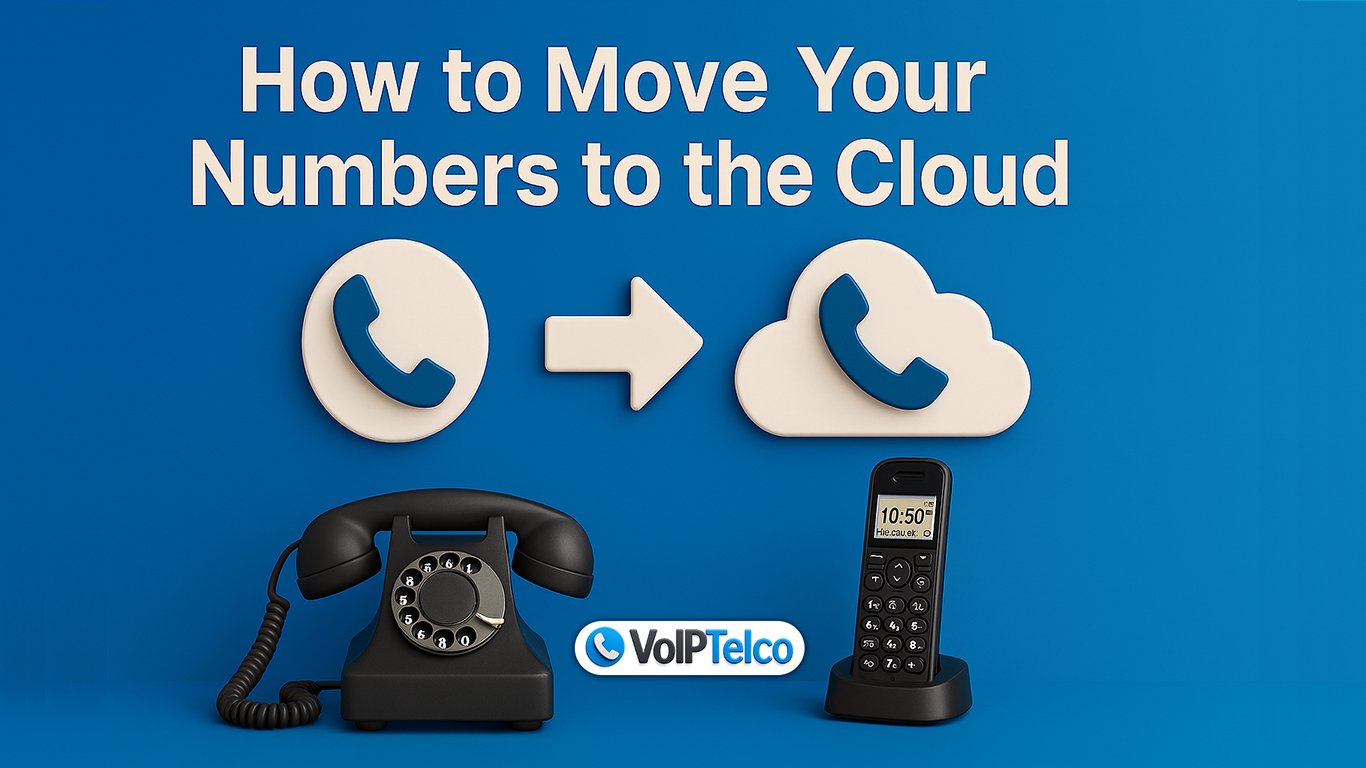How to Move Your Numbers to the Cloud: UK Business Guide

The way UK businesses communicate is undergoing a massive transformation. For decades, companies relied on fixed PSTN and ISDN lines to keep phones ringing, connect customers to staff, and anchor their brand presence. But by December 2025, those networks will be permanently switched off as part of the UK’s migration to all-IP services.
That change leaves businesses with one pressing question: how do we keep our numbers?
Your phone number is more than just digits. It’s the lifeline customers use to reach you, it’s embedded in marketing, and it carries years of trust. Losing access — even for a day — can mean missed opportunities, lost sales, and reputational damage.
The solution is to move your numbers to the cloud. This process, known as number porting, allows you to transfer your existing phone numbers from a traditional provider to a VoIP or hosted telephony platform. Once ported, your numbers become location-independent and accessible across desk phones, softphones, and mobile apps.
This in-depth guide will explain why moving your numbers matters, how the porting process works in the UK, what costs and compliance rules to expect, industry-specific case studies, common pitfalls, and future trends.
By the end, you’ll know exactly how to plan, execute, and optimise a migration strategy that protects your numbers and future-proofs your business.
Why Moving Numbers to the Cloud Matters
The decision to move your phone numbers to the cloud is not just about technology — it’s about protecting continuity, ensuring customer trust, and preparing for the future. Let’s explore the main reasons UK businesses must prioritise this change.
1. The PSTN switch-off is inevitable
The single biggest driver is the UK PSTN and ISDN switch-off, scheduled to complete by December 2025. After this date, analogue voice services will no longer function. Businesses that rely on ISDN30 lines or PSTN handsets will find themselves unable to make or receive calls.
BT Openreach has already begun withdrawing services in certain areas (known as “stop-sell” exchanges), meaning new ISDN lines are unavailable, and businesses are pushed toward VoIP alternatives. Waiting until the last moment risks encountering supply bottlenecks, long lead times, and rushed migrations.
2. Customer continuity
Your business phone number is a trusted identity marker. Customers remember it, store it in their phones, and associate it with your brand. If that number suddenly disappears or doesn’t connect, it causes confusion and damages credibility. Moving numbers to the cloud ensures customers continue to reach you, no matter where your team is located or how your technology evolves.
3. Flexibility for hybrid and remote work
The pandemic normalised hybrid working, and many UK businesses now operate with staff in multiple locations. Cloud-hosted numbers allow calls to reach employees at home, on mobiles, or in different offices seamlessly. Instead of being tied to a single handset on a single desk, staff can carry their business identity anywhere.
4. Scalability and agility
Traditional line provisioning often required weeks of lead time, engineer visits, and physical cabling. In contrast, cloud providers allow you to add or remove numbers instantly from a web portal. This scalability is critical for businesses with seasonal demand, fast growth, or distributed teams.
5. Cost savings
Cloud telephony eliminates ISDN line rental charges and reduces call costs. For example, a small firm with 20 ISDN lines might pay £200–£250 per month in rental fees alone, before call charges. By moving to VoIP, the same firm could reduce monthly spend by 40–60% while gaining access to advanced features like call recording, IVR menus, and detailed analytics.
6. Business resilience
Cloud numbers aren’t tied to a physical exchange or office. If your building experiences a power cut or broadband outage, calls can automatically fail over to mobiles, other branches, or voicemail. This resilience protects business continuity during local disruptions.
Understanding Number Porting in the UK
If you’re planning to move your numbers to the cloud, you’ll hear the term number porting repeatedly. At its simplest, number porting is the regulated process of transferring your existing phone numbers from one telecoms provider to another. In the context of cloud migration, it means moving your numbers from a legacy PSTN or ISDN provider to a new VoIP or hosted telephony provider.
What exactly is number porting?
Number porting ensures that your business phone numbers remain the same while the underlying technology changes. Customers continue to dial the same numbers they’ve always used, but the calls are routed through your new cloud provider rather than your old network.
Who regulates number porting in the UK?
The process is overseen by Ofcom, the UK’s communications regulator. Under General Condition C7, Ofcom requires that:
Types of numbers you can port
– Geographic numbers (01/02)
– Non-geographic numbers (03/08)
– Mobile numbers (07)
Porting methods
– Single-line port
– Block or DDI range port
– Partial port
Timelines for porting
Single numbers typically take around 10 working days. Larger blocks or DDI ranges may take 15–20 working days. Multi-site or complex ports can stretch to 4–6 weeks. These timelines highlight why planning early is critical — especially with the 2025 PSTN deadline looming.
Step-by-Step Migration Process
Moving your numbers to the cloud isn’t something that happens overnight. Success depends on careful planning, accurate paperwork, and proactive testing. Here’s a seven-step roadmap that UK businesses can follow to minimise disruption.
Step 1: Audit your numbers
Before you begin, create a complete inventory of all numbers currently in use. Many businesses are surprised to discover they are paying for lines they no longer use.
This audit ensures you don’t accidentally lose an important number during migration.
Step 2: Select the right cloud provider
Choosing a reliable provider is essential. Consider:
Don’t just compare prices — weigh the provider’s long-term suitability for your business.
Step 3: Submit your porting request
Once you’ve chosen a provider:
Accuracy here saves days or even weeks of delay.
Step 4: Validation by the losing provider
Your existing provider reviews the porting request to confirm the numbers belong to your account, check for outstanding balances or contract restrictions, and verify the requested ranges. If there’s a mismatch, the request is rejected and you’ll need to resubmit.
Step 5: Schedule the port
Once validated, your new provider books a port date. For small ports, downtime is usually minimal — sometimes just minutes. Larger ports are scheduled in windows (e.g., 10:00–13:00) to give engineers flexibility. Ports are rarely scheduled on Mondays or Fridays to avoid extended downtime over weekends. Communicate the schedule internally so staff know when to expect the cutover.
Step 6: Cutover and testing
On the port date, incoming calls are routed to your new cloud provider. Test every key scenario: inbound/outbound calls, call queues, voicemail, IVRs, and failover to mobiles. Keep staff on standby to report issues. Most ports go smoothly, but testing ensures you spot anomalies quickly.
Step 7: Decommission old services
Do not cancel old ISDN/PSTN lines until you’ve confirmed the port was successful. Run both systems in parallel for a few days if risk tolerance is low. Once satisfied, cancel unused services to stop unnecessary charges.
Pro Tip: Stage your migration — Large organisations should avoid a “big bang” port. Instead, port one site or department first, test thoroughly, then roll out in phases across other locations. This phased approach reduces risk and builds internal confidence.
Costs, Timelines & ROI
One of the first questions most businesses ask is: how much will it cost to move numbers to the cloud? The answer depends on your provider, the number of lines, and the complexity of your setup — but here’s what you can expect in the UK market:
Typical timelines: Small ports (1–5 numbers) complete in 10 working days, while larger DDI ranges can take 3–4 weeks. Complex enterprise ports may stretch to 6+ weeks. ROI is usually visible within the first 12 months thanks to reduced line rental, cheaper call charges, and productivity gains.
Compliance & Risks
Moving numbers to the cloud isn’t just a technical process — it’s a regulated one. Businesses must comply with Ofcom rules, GDPR, and sector-specific obligations. Risks typically arise from poor planning or provider issues.
Mitigation involves due diligence: pick an Ofcom-registered provider, check references, and ensure clear SLAs and compliance certifications are in place.
Industry-Specific Considerations
Every business faces the same PSTN deadline, but industries have unique requirements when moving to the cloud:
By tailoring your migration strategy to industry-specific compliance and workflows, you can reduce disruption and unlock new value from your phone system.
Case Studies
Midlands Law Firm (50 staff): Migrated ISDN30 lines to cloud VoIP, kept all direct dial numbers, and integrated with Microsoft Teams. Result: reduced telecom spend by 35% and improved call handling efficiency.
London Retail Chain (10 stores): Ported geographic numbers, added call recording for compliance, and deployed softphones for remote staff. Result: higher customer satisfaction and faster response times.
Healthcare Practice (12 staff): Retained long-standing surgery number, enabled voicemail-to-email for triage, and configured time-of-day routing. Result: fewer missed calls during peak demand.
Common Mistakes to Avoid
FAQs
Future Outlook
Number porting to the cloud is just the first step. The future of business communications lies in AI-driven analytics, predictive call routing, and seamless integration with collaboration tools. By acting now, UK businesses not only prepare for the PSTN switch-off but also gain a competitive advantage in customer experience and operational efficiency.
Ready to Move Your Numbers?
Don’t wait until the 2025 deadline. Start your migration today with VoIPTelco’s UK-based team. We’ll guide you through every step, ensure compliance, and guarantee minimal downtime.






